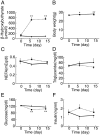Fgf21 impairs adipocyte insulin sensitivity in mice fed a low-carbohydrate, high-fat ketogenic diet
- PMID: 23874946
- PMCID: PMC3706421
- DOI: 10.1371/journal.pone.0069330
Fgf21 impairs adipocyte insulin sensitivity in mice fed a low-carbohydrate, high-fat ketogenic diet
Abstract
Background: A low-carbohydrate, high-fat ketogenic diet (KD) induces hepatic ketogenesis and is believed to affect energy metabolism in mice. As hepatic Fgf21 expression was markedly induced in mice fed KD, we examined the effects of KD feeding on metabolism and the roles of Fgf21 in metabolism in mice fed KD using Fgf21 knockout mice.
Methodology/principal findings: We examined C57BL/6 mice fed KD for 6 or 14 days. Blood β-hydroxybutyrate levels were greatly increased at 6 days, indicating that hepatic ketogenesis was induced effectively by KD feeding for 6 days. KD feeding for 6 and 14 days impaired glucose tolerance and insulin sensitivity, although it did not affect body weight, blood NEFA, and triglyceride levels. Hepatic Fgf21 expression and blood Fgf21 levels were markedly increased in mice fed KD for 6 days. Blood β-hydroxybutyrate levels in the knockout mice fed KD for 6 days were comparable to those in wild-type mice fed KD, indicating that Fgf21 is not required for ketogenesis. However, the impaired glucose tolerance and insulin sensitivity caused by KD feeding were improved in the knockout mice. Insulin-stimulated Akt phosphorylation was significantly decreased in the white adipose tissue in wild-type mice fed KD compared with those fed normal chow, but not in the muscle and liver. Its phosphorylation in the white adipose tissue was significantly increased in the knockout mice fed KD compared with wild-type mice fed KD. In contrast, hepatic gluconeogenic gene expression in Fgf21 knockout mice fed KD was comparable to those in the wild-type mice fed KD.
Conclusions/significance: The present findings indicate that KD feeding impairs insulin sensitivity in mice due to insulin resistance in white adipose tissue. In addition, our findings indicate that Fgf21 induced to express by KD is a negative regulator of adipocyte insulin sensitivity in adaptation to a low-carbohydrate malnutritional state.
Conflict of interest statement
Figures








Similar articles
-
Fibroblast growth factor 21 regulates lipolysis in white adipose tissue but is not required for ketogenesis and triglyceride clearance in liver.Endocrinology. 2009 Oct;150(10):4625-33. doi: 10.1210/en.2009-0119. Epub 2009 Jul 9. Endocrinology. 2009. PMID: 19589869
-
Hepatic insulin resistance and increased hepatic glucose production in mice lacking Fgf21.J Endocrinol. 2015 Sep;226(3):207-17. doi: 10.1530/JOE-15-0136. Epub 2015 Jul 22. J Endocrinol. 2015. PMID: 26203166
-
A very low carbohydrate ketogenic diet improves glucose tolerance in ob/ob mice independently of weight loss.Am J Physiol Endocrinol Metab. 2009 Nov;297(5):E1197-204. doi: 10.1152/ajpendo.00357.2009. Epub 2009 Sep 8. Am J Physiol Endocrinol Metab. 2009. PMID: 19738035 Free PMC article.
-
The Regulatory Role of the Central and Peripheral Serotonin Network on Feeding Signals in Metabolic Diseases.Int J Mol Sci. 2022 Jan 29;23(3):1600. doi: 10.3390/ijms23031600. Int J Mol Sci. 2022. PMID: 35163521 Free PMC article. Review.
-
Biological role, clinical significance, and therapeutic possibilities of the recently discovered metabolic hormone fibroblastic growth factor 21.Eur J Endocrinol. 2012 Sep;167(3):301-9. doi: 10.1530/EJE-12-0357. Epub 2012 Jun 27. Eur J Endocrinol. 2012. PMID: 22740503 Review.
Cited by
-
Postnatal exercise protects offspring from high-fat diet-induced reductions in subcutaneous adipocyte beiging in C57Bl6/J mice.J Nutr Biochem. 2022 Jan;99:108853. doi: 10.1016/j.jnutbio.2021.108853. Epub 2021 Sep 11. J Nutr Biochem. 2022. PMID: 34517093 Free PMC article.
-
Endocrine FGFs: Evolution, Physiology, Pathophysiology, and Pharmacotherapy.Front Endocrinol (Lausanne). 2015 Sep 29;6:154. doi: 10.3389/fendo.2015.00154. eCollection 2015. Front Endocrinol (Lausanne). 2015. PMID: 26483756 Free PMC article. Review.
-
The impact of ketogenic diet on some metabolic and non-metabolic diseases: Evidence from human and animal model experiments.Food Sci Nutr. 2024 Jan 8;12(3):1444-1464. doi: 10.1002/fsn3.3873. eCollection 2024 Mar. Food Sci Nutr. 2024. PMID: 38455178 Free PMC article. Review.
-
Effects of Ketogenic Diets on Cardiovascular Risk Factors: Evidence from Animal and Human Studies.Nutrients. 2017 May 19;9(5):517. doi: 10.3390/nu9050517. Nutrients. 2017. PMID: 28534852 Free PMC article. Review.
-
Novel Mediators of Adipose Tissue and Muscle Crosstalk.Curr Obes Rep. 2015 Dec;4(4):411-7. doi: 10.1007/s13679-015-0174-7. Curr Obes Rep. 2015. PMID: 26349436 Review.
References
-
- Itoh N, Ornitz DM (2008) Functional evolutionary history of the mouse Fgf gene familiy. Dev. Dyn. 237: 18–27. - PubMed
-
- Nishimura T, Nakatake Y, Konishi M, Itoh N (2000) Identification of a novel FGF, FGF-21, preferentially expressed in the liver. Biochim. Biophys. Acta. 1492: 203–206. - PubMed
-
- Kharitonenkov A, Larsen P (2011) FGF21 reloaded: challenges of a rapidly growing field. Trends Endocrinol. Metab. 22: 81–86. - PubMed
Publication types
MeSH terms
Substances
LinkOut - more resources
Full Text Sources
Other Literature Sources
Molecular Biology Databases
Research Materials

